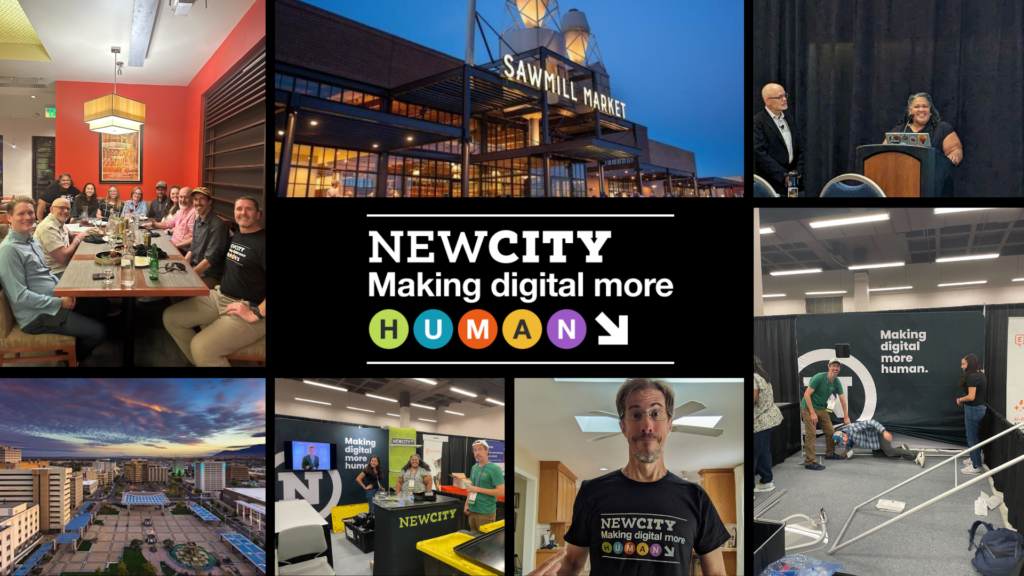Our annual trek back to HighEdWeb is when we can spend the most time living one of our core values – Learn, Lead and Share: Be a student AND an expert. Feed your brain, put it in action, and share what you’ve learned. It always comes back.
In between preparing for our own sessions, our team was busy catching up on the latest in content strategy, UX research, AI tools and governance best practices.
Here’s a roundup of our favorite sessions with presenters who are finding innovative ways to use time-tested and new tools to empower their higher ed work. Their ideas got us thinking, and we hope they do the same for you.
I really appreciated the way Nate tried to apply structure and templatize what can otherwise be a really resource-intensive and organic process. Personas are a tool we’re used to seeing in other parts of a website redesign process, but this creative application of them goes a long way toward scaling their user training and finding efficiencies. Nate also used the concept of “hidden objectives” as a way to make sure the trainings were equally effective at covering the items that are important to trainees, while also accomplishing items important to his team for a variety of reasons. His talk was also a blend of telling his story, while helping folks reflect on their own situations in tangible ways they could take back to their teams.
Having prior experience with conducting user trainings at scale, conveying the nuances of how to make trainings more successful can be a challenge, especially for folks new to that field, and CMS training often comes up in our project work. The use of personas is one more tool in the toolbox to consider in our train-the-trainer sessions that could help make them more approachable.
You might also like: Teach Editors How to Use a Design System
This talk was a firehose of AI-driven tools and use cases based on the presenter’s use over at MIT. I head up NewCity’s dev team and am always on the lookout for similar things. We’re already trying out some of the tools we learned about in this presentation (especially NotebookLM) . This talk won the red stapler award!
You might also like: Developing with AI
Interesting presentation about how 4 kitchens built and fed a custom chat driven by Azure OpenAI. They talked about structuring the data, getting it into the system, tuning the results, and adding sensible guardrails.
They kept arriving at the fact that content matters. Part of the Yale sites lesson was that on poorly written pages that had way too much information, they ended up having to go in and rewrite those pages and optimize them for the web. Then your chat bot is smarter because it’s more easily parsing the information on the site just like a human would. And that’s a really good reminder for us all, because, yes they had a chat bot, but they had improved website content and all of those pages that the chat bot was training on. You’ve got to feed the chatbot good food. If you give it a good diet, it’s going to be a healthy chat, right?
You might also like:
Connecting data from your many channels to your enrollment goals was a great session that showed practical strategies to build insights. I walked away with a reminder of the value of multi-channeled approaches. Isaac Williams reminded us of the marketing principle of ‘The Rule of 7’. It takes at least seven times for a customer to see a brand’s message before purchasing. As colleges and universities, how often and in what ways are we serving up and reaffirming the value of our brand to prospective students? In what ways are we informing and impacting their choice?
You might also like:
No Shady Data: Implementing GA4 for quality Insights in higher ed
Joyce Peralta from McGill University shared a case study of the journey they took to develop a digital governance model that combines services, tools, and policy within a unified community of practice. They were thoughtful in developing their plan, beginning in 2018 by benchmarking their practices compared to other universities, then auditing all their existing policies and guidelines. They made sure they could connect every policy with a responsible party, which Joyce said was often hard! They’ve been smart about seeing this as an iterative, living thing – evaluating and testing the model periodically.
McGill’s story is very timely for us as we regularly advise clients on governance models and best practices. We were able to attend the session with a couple of our clients so it is stimulating some great discussion!
You might also like:





